
Muskeg
Encyclopedia
Muskeg is an acidic soil
type common in Arctic
and boreal
areas, although it is found in other northern climates as well. Muskeg is approximately synonymous with bogland but muskeg is the standard term in Western Canada and Alaska, while 'bog' is common elsewhere. The term is of Cree
origin, maskek (ᒪᐢᑫᐠ) meaning low lying marsh. Large tracts of this soil existing in Siberia may be called muskeg or bogland interchangeably. Muskeg consists of dead plants in various states of decomposition
(as peat
), ranging from fairly intact sphagnum moss
, to sedge peat, to highly decomposed muck. Pieces of wood
can make up five to 15 percent of the peat soil
. Muskeg tends to have a water table
near the surface. The sphagnum
moss forming it can hold 15 to 30 times its own weight in water, allowing the spongy wet muskeg to form on sloping ground. Muskeg patches are ideal habitats for beaver
s, pitcher plant
s, agaric mushrooms
and a variety of other organisms.
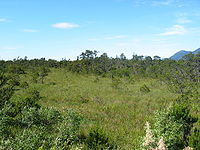 Muskeg forms because permafrost
Muskeg forms because permafrost
, clay
or bedrock
prevents water drainage. The water from rain and snow collects, forming permanently waterlogged vegetation and stagnant pools. Muskeg is wet, acidic, and relatively infertile which prevents large trees from growing, although stunted Shore Pine, cottonwood, some species of willow
, and Black Spruce
are typically found. It needs two conditions to develop: abundant rain and cool summers. A dead plant that falls on dry soil is normally attacked by bacteria
and fungi and quickly rots. If the same plant lands in water or on saturated soil it faces a different fate. Less oxygen is available under water, so aerobic bacteria and fungi fail to colonize the submerged debris effectively. In addition, cool temperatures retard bacterial and fungal growth. This causes slow decomposition, and thus the plant debris gradually accumulates to form peat and eventually muskeg. Depending on the underlying topography
of the land, muskeg can reach depths greater than 30 metres (100 ft).
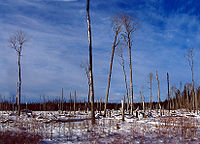 Although at first glance muskeg resembles a plain
Although at first glance muskeg resembles a plain
covered with short grasses, a closer look will reveal a bizarre and almost unearthly landscape. Small stands of stunted and often dead trees that vaguely resemble Bonsai trees grow where land protrudes above the water table
, with small pools of water stained dark red scattered about. Its grassland appearance invites the unwary to walk on it, but even the most solid muskeg is spongy and waterlogged. Traveling through muskeg is a strange and dangerous experience for the unaccustomed. Muskeg can grow atop bodies of water, especially small ponds and streams. Because of the water beneath, the muskeg surface sometimes ripples underfoot. Thinner patches allow large animals to fall through, becoming trapped under the muskeg and drowning. Moose are at a special disadvantage in muskeg due to their long legs, minimal hoof area, and great weight. Young moose are occasionally encountered in muskeg-covered ponds submerged up to their torsos or necks, having been unaware of the unstable ground.
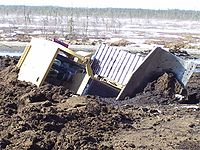 Muskeg can be a significant impediment to transportation. During the 1870s, muskeg in Northern Ontario
Muskeg can be a significant impediment to transportation. During the 1870s, muskeg in Northern Ontario
was reported to have swallowed a railroad engine
whole when a track was laid on muskeg instead of clearing down to bedrock
. Many other instances have been reported of heavy construction equipment vanishing into muskeg in the spring
as the frozen muskeg beneath the vehicle thawed. Construction in muskeg-laden areas sometimes requires the complete removal of the soil and filling with gravel. If the muskeg is not completely cleared to bedrock, its high water content will cause buckling and distortion from winter freezing, much like permafrost
.
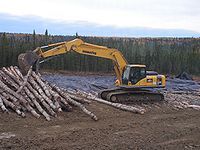 One method of working atop muskeg is to place large logs on the ground, then cover those logs with a thick layer of clay
One method of working atop muskeg is to place large logs on the ground, then cover those logs with a thick layer of clay
or other stable material. This is commonly called a corduroy road
. To increase the effectiveness of the corduroy, prevent erosion
, and allow removal of material with less disturbance to the muskeg, a geotextile
fabric is sometimes placed down before the logs.
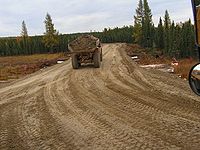
Soil pH
The soil pH is a measure of the acidity or basicity in soils. pH is defined as the negative logarithm of the activity of hydrogen ions in solution. It ranges from 0 to 14, with 7 being neutral. A pH below 7 is acidic and above 7 is basic. Soil pH is considered a master variable in soils as it...
type common in Arctic
Arctic
The Arctic is a region located at the northern-most part of the Earth. The Arctic consists of the Arctic Ocean and parts of Canada, Russia, Greenland, the United States, Norway, Sweden, Finland, and Iceland. The Arctic region consists of a vast, ice-covered ocean, surrounded by treeless permafrost...
and boreal
Boreal ecosystem
The term boreal is usually applied to ecosystems localized in subarctic and subantarctic zones, although Austral is also used for the latter....
areas, although it is found in other northern climates as well. Muskeg is approximately synonymous with bogland but muskeg is the standard term in Western Canada and Alaska, while 'bog' is common elsewhere. The term is of Cree
Cree language
Cree is an Algonquian language spoken by approximately 117,000 people across Canada, from the Northwest Territories and Alberta to Labrador, making it the aboriginal language with the highest number of speakers in Canada. It is also spoken in the U.S. state of Montana...
origin, maskek (ᒪᐢᑫᐠ) meaning low lying marsh. Large tracts of this soil existing in Siberia may be called muskeg or bogland interchangeably. Muskeg consists of dead plants in various states of decomposition
Decomposition
Decomposition is the process by which organic material is broken down into simpler forms of matter. The process is essential for recycling the finite matter that occupies physical space in the biome. Bodies of living organisms begin to decompose shortly after death...
(as peat
Peat
Peat is an accumulation of partially decayed vegetation matter or histosol. Peat forms in wetland bogs, moors, muskegs, pocosins, mires, and peat swamp forests. Peat is harvested as an important source of fuel in certain parts of the world...
), ranging from fairly intact sphagnum moss
Moss
Mosses are small, soft plants that are typically 1–10 cm tall, though some species are much larger. They commonly grow close together in clumps or mats in damp or shady locations. They do not have flowers or seeds, and their simple leaves cover the thin wiry stems...
, to sedge peat, to highly decomposed muck. Pieces of wood
Wood
Wood is a hard, fibrous tissue found in many trees. It has been used for hundreds of thousands of years for both fuel and as a construction material. It is an organic material, a natural composite of cellulose fibers embedded in a matrix of lignin which resists compression...
can make up five to 15 percent of the peat soil
Soil
Soil is a natural body consisting of layers of mineral constituents of variable thicknesses, which differ from the parent materials in their morphological, physical, chemical, and mineralogical characteristics...
. Muskeg tends to have a water table
Water table
The water table is the level at which the submarine pressure is far from atmospheric pressure. It may be conveniently visualized as the 'surface' of the subsurface materials that are saturated with groundwater in a given vicinity. However, saturated conditions may extend above the water table as...
near the surface. The sphagnum
Sphagnum
Sphagnum is a genus of between 151 and 350 species of mosses commonly called peat moss, due to its prevalence in peat bogs and mires. A distinction is made between sphagnum moss, the live moss growing on top of a peat bog on one hand, and sphagnum peat moss or sphagnum peat on the other, the...
moss forming it can hold 15 to 30 times its own weight in water, allowing the spongy wet muskeg to form on sloping ground. Muskeg patches are ideal habitats for beaver
Beaver
The beaver is a primarily nocturnal, large, semi-aquatic rodent. Castor includes two extant species, North American Beaver and Eurasian Beaver . Beavers are known for building dams, canals, and lodges . They are the second-largest rodent in the world...
s, pitcher plant
Pitcher plant
Pitcher plants are carnivorous plants whose prey-trapping mechanism features a deep cavity filled with liquid known as a pitfall trap. It has been widely assumed that the various sorts of pitfall trap evolved from rolled leaves, with selection pressure favouring more deeply cupped leaves over...
s, agaric mushrooms
Agaricales
The fungal order Agaricales, also known as gilled mushrooms , or euagarics, contains some of the most familiar types of mushrooms. The order has 33 extant families, 413 genera, and over 13000 described species, along with five extinct genera known only from the fossil record...
and a variety of other organisms.
Composition

Permafrost
In geology, permafrost, cryotic soil or permafrost soil is soil at or below the freezing point of water for two or more years. Ice is not always present, as may be in the case of nonporous bedrock, but it frequently occurs and it may be in amounts exceeding the potential hydraulic saturation of...
, clay
Clay
Clay is a general term including many combinations of one or more clay minerals with traces of metal oxides and organic matter. Geologic clay deposits are mostly composed of phyllosilicate minerals containing variable amounts of water trapped in the mineral structure.- Formation :Clay minerals...
or bedrock
Bedrock
In stratigraphy, bedrock is the native consolidated rock underlying the surface of a terrestrial planet, usually the Earth. Above the bedrock is usually an area of broken and weathered unconsolidated rock in the basal subsoil...
prevents water drainage. The water from rain and snow collects, forming permanently waterlogged vegetation and stagnant pools. Muskeg is wet, acidic, and relatively infertile which prevents large trees from growing, although stunted Shore Pine, cottonwood, some species of willow
Willow
Willows, sallows, and osiers form the genus Salix, around 400 species of deciduous trees and shrubs, found primarily on moist soils in cold and temperate regions of the Northern Hemisphere...
, and Black Spruce
Black Spruce
Picea mariana is a species of spruce native to northern North America, from Newfoundland west to Alaska, and south to northern New York, Minnesota and central British Columbia...
are typically found. It needs two conditions to develop: abundant rain and cool summers. A dead plant that falls on dry soil is normally attacked by bacteria
Bacteria
Bacteria are a large domain of prokaryotic microorganisms. Typically a few micrometres in length, bacteria have a wide range of shapes, ranging from spheres to rods and spirals...
and fungi and quickly rots. If the same plant lands in water or on saturated soil it faces a different fate. Less oxygen is available under water, so aerobic bacteria and fungi fail to colonize the submerged debris effectively. In addition, cool temperatures retard bacterial and fungal growth. This causes slow decomposition, and thus the plant debris gradually accumulates to form peat and eventually muskeg. Depending on the underlying topography
Topography
Topography is the study of Earth's surface shape and features or those ofplanets, moons, and asteroids...
of the land, muskeg can reach depths greater than 30 metres (100 ft).
Description

Plain
In geography, a plain is land with relatively low relief, that is flat or gently rolling. Prairies and steppes are types of plains, and the archetype for a plain is often thought of as a grassland, but plains in their natural state may also be covered in shrublands, woodland and forest, or...
covered with short grasses, a closer look will reveal a bizarre and almost unearthly landscape. Small stands of stunted and often dead trees that vaguely resemble Bonsai trees grow where land protrudes above the water table
Water table
The water table is the level at which the submarine pressure is far from atmospheric pressure. It may be conveniently visualized as the 'surface' of the subsurface materials that are saturated with groundwater in a given vicinity. However, saturated conditions may extend above the water table as...
, with small pools of water stained dark red scattered about. Its grassland appearance invites the unwary to walk on it, but even the most solid muskeg is spongy and waterlogged. Traveling through muskeg is a strange and dangerous experience for the unaccustomed. Muskeg can grow atop bodies of water, especially small ponds and streams. Because of the water beneath, the muskeg surface sometimes ripples underfoot. Thinner patches allow large animals to fall through, becoming trapped under the muskeg and drowning. Moose are at a special disadvantage in muskeg due to their long legs, minimal hoof area, and great weight. Young moose are occasionally encountered in muskeg-covered ponds submerged up to their torsos or necks, having been unaware of the unstable ground.
Surface strength

Ontario
Ontario is a province of Canada, located in east-central Canada. It is Canada's most populous province and second largest in total area. It is home to the nation's most populous city, Toronto, and the nation's capital, Ottawa....
was reported to have swallowed a railroad engine
Engine
An engine or motor is a machine designed to convert energy into useful mechanical motion. Heat engines, including internal combustion engines and external combustion engines burn a fuel to create heat which is then used to create motion...
whole when a track was laid on muskeg instead of clearing down to bedrock
Bedrock
In stratigraphy, bedrock is the native consolidated rock underlying the surface of a terrestrial planet, usually the Earth. Above the bedrock is usually an area of broken and weathered unconsolidated rock in the basal subsoil...
. Many other instances have been reported of heavy construction equipment vanishing into muskeg in the spring
Spring (season)
Spring is one of the four temperate seasons, the transition period between winter and summer. Spring and "springtime" refer to the season, and broadly to ideas of rebirth, renewal and regrowth. The specific definition of the exact timing of "spring" varies according to local climate, cultures and...
as the frozen muskeg beneath the vehicle thawed. Construction in muskeg-laden areas sometimes requires the complete removal of the soil and filling with gravel. If the muskeg is not completely cleared to bedrock, its high water content will cause buckling and distortion from winter freezing, much like permafrost
Permafrost
In geology, permafrost, cryotic soil or permafrost soil is soil at or below the freezing point of water for two or more years. Ice is not always present, as may be in the case of nonporous bedrock, but it frequently occurs and it may be in amounts exceeding the potential hydraulic saturation of...
.

Clay
Clay is a general term including many combinations of one or more clay minerals with traces of metal oxides and organic matter. Geologic clay deposits are mostly composed of phyllosilicate minerals containing variable amounts of water trapped in the mineral structure.- Formation :Clay minerals...
or other stable material. This is commonly called a corduroy road
Corduroy road
A corduroy road or log road is a type of road made by placing sand-covered logs perpendicular to the direction of the road over a low or swampy area....
. To increase the effectiveness of the corduroy, prevent erosion
Erosion
Erosion is when materials are removed from the surface and changed into something else. It only works by hydraulic actions and transport of solids in the natural environment, and leads to the deposition of these materials elsewhere...
, and allow removal of material with less disturbance to the muskeg, a geotextile
Geotextile
Geotextiles are permeable fabrics which, when used in association with soil, have the ability to separate, filter, reinforce, protect, or drain...
fabric is sometimes placed down before the logs.


